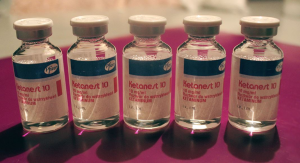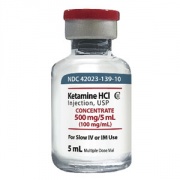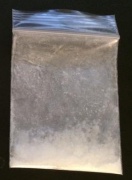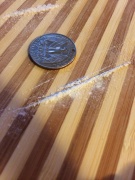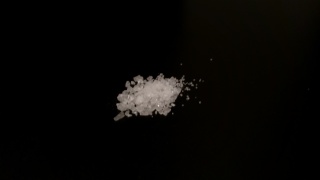Ketamine
Ketamine is a dissociative anesthetic that belongs to the arylcyclohexylamine class, and commonly used in human medical and veterinary care. It has a very wide safety margin, with an anesthetic dose being as much as ten times a recreational dose in an inexperienced user. Ketamine is generally sold to the recreational user in one of two forms: in the evaporated salts, which are sold as a powder, or crystals (often referred to as shards), as well as in multi-dose vials for use in veterinary and human medicine. These vials may have concentrations ranging from 5mg/mL all the way up to 100mg/mL, and vary by manufacturer. One manufacturer, Parke-Davis, reports cases of accidental overdoses of ketamine as much as ten times higher than that required for surgery (which is to say 40-100x a recreational dose) "with no obvious, lasting effects." It is, therefore, reasonable to consider it a drug of relatively safe usage. Because ketamine is a dissociative and an anesthetic, users are prone to becoming injured by interaction with their environment and have died from things such as drowning (DM Turner). Overdose, however, is unlikely.
History
Ketamine was originally produced by Parke-Davis laboratories in the early 1960s, and its recreational use was first reported in 1965; by the early 1970s, the US FDA was concerned about its use as a recreational drug. In the early 1990s, the US "Drug Czar" labeled ketamine as an "emerging drug" because of its involvement in the electronic music scene, and by 1999, it had been scheduled in the United States (Schedule III), although this designation is only applicable when the drug is intended for use in humans.
Dosage
{{#tdose: ketamine }}
Ketamine is usually either injected intramuscularly (although intravenous administration does happen) or insufflated. Additional routes of administration are "plugging" (rectal) and orally. Oral availability of ketamine is poor.
These numbers are quoted directly from Erowid (which uses subjective dosage reports). Individual dosages will vary based on route of administration, tolerance and weight of the user, purity of the drug, as well as other conditions. It is always wise to start with a small dose and work up to a recreational dose. Remember, you cannot take less of the drug you have taken, but you can always take more.
A note on the "K-hole"
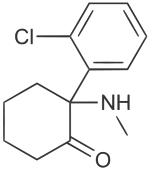
There is no "guaranteed" dose to "hole" with ketamine. The "k-hole" as it is called is a state of full dissociative anesthesia in which the user is able to retain a semblance of consciousness. The effect associated with this is ego death; that is, the dissolution of the ego, the loss of the perspective of "I" in perception. It is a tricky dose to attain. Reaching too far with dosage will result in full anesthesia without memory of the experience and is worthless for recreational or psychonautical purposes. Too low a dosage will result in a mild sedation and body load, but no ego death, and redosing when anesthetized is tricky.
It is posited that using a needle and a precisely measured dose is more likely to get a user to a full state of ego death, the k-hole, due to the lack of titration of dosage, rapid come-up, and exactly-metered dosage. Finding a dosage that "works for you" is important, and there will need to be a period of experimentation before such a dose is found. Assuming the user does not approach this dose very often, tolerance should not build, and it can be consistently used to reach that level of effect/ego death.
It may be helpful for the user to measure out doses in syringes before using if a re-dose is desired; pulling a new shot can be difficult while under the effects of ketamine, and takes time while the drug is wearing off. Administering a shot while anesthetized can be perilous at best; for this reason, re-dosing is not recommended. If one must re-dose, use of an "auto-ject" like device (a spring loaded syringe) is convenient.
Because the "k-hole" involves full dissociative anesthesia, it is crucial that the user be in a safe place, physically, such as lying flat in bed. It may be useful to have a sitter present because arousal from the k-hole may be disorienting.
Understand, however, that there is no guaranteed mechanism for "reaching the hole," and it takes practice. Become familiar with the drug before taking large doses such as those required to reach the "hole." Find a dose that works for you.
Oral
1-4mg/lb of body mass. Doses higher than 3mg/lb may exceed the recreational window and leave the user anesthetized rather than "tripping." Doses of 2-3mg/lb may incur greater (short-term) memory loss and have little additional value as a psychedelic.
Insufflated
Threshold effects may begin as low as 5mg, and recreational doses can range up to 150mg, with common doses being 30-75mg. Insufflated doses above 100mg are often enough to enter a K-Hole. As above, higher doses may not yield greater desirable effect. Ketamine is reported to be fairly gentle on the nasal tissues compared to brominated phenethylamines and organofluorides.
Intramuscular injection
Typically 1mg/lb body mass for IM injection is quite sufficient for a full dissociative experience. Doses of .5-.75mg/lb are more "threshold" and cogent experiences. Doses exceeding 1mg/lb body mass usually result in full anesthesia with little recall of the experience and may take longer to recover. There may be short-term memory loss with higher doses.
Intravenous injection
Intravenous injection is possible with ketamine. The doses are the same as for intramuscular injection. However, with intravenous injection, the user can become fully anesthetized before she is able to remove the needle from her body. For this reason alone intravenous injection of ketamine is discouraged. Additionally, intramuscular injection provides a near-identical experience with the only major difference being a shorter (< 1 minute vs < 2 minutes) come-up.
Duration
| Onset | 10-75 minutes |
| Total | 1-2 hours |
| Onset | 7.5-20 minutes |
| Total | 1-2 hours |
| Onset | <2 minutes |
| Peak | 1-2 hours |
| After-effects | 60 minutes |
Effects
Positive
- Ego death is a state often sought in the use of psychedelics, and ketamine is often considered to be a very quick route to ego death, in a repeatable, safe way.
- Some users report euphoria.
- Pain relief.
- There has been some indication that ketamine, in low doses (20-30mg), can be an effective anti-depressant.
Neutral
Negative
- Long-term, chronic usage may lead to psychosis.
- Bladder and lower urinary tract discomfort, up to and including tissue necrosis requiring replacement of bladder, ureters, and urethra, has been reported[1]. If these effects are noticed, discontinue use immediately. There is no known treatment for this except cessation of use. Symptoms may subside with discontinuation.
- Ketamine is well-known in the psychedelics community to be habit-forming. It may not be technically 'physically addictive', but certainly psychological dependence is an issue that is widely reported.
- Any substance used intramuscularly or intravenously can be associated with abscesses among other hazards.
After effects
- Ketamine takes much longer to return to a complete baseline than is immediately apparent to the user. While major effects subside in usually less than an hour, some research has shown it can take a day or longer for more subtle psychological effects to subside. For this reason, it is important to be careful with redosing and daily usage.
Harm Reduction
See Dissociative Harm Reduction for general information.
Preparation of injectable ketamine solution from "street" ketamine
It is assumed that ketamine provided is simply the evaporated shards of veterinary-grade ketamine (e.g., Ketalar, Ketaset, etc). These instructions do not cover "extraction" of ketamine from non-ketamine-containing mixtures. Additionally, the assumed route of administration here is intramuscular, not intravenous; intravenous solutions can have a higher concentration of ketamine per ml.
A note on purity of "street" ketamine
Anecdotal evidence suggests that even the "cleanest" ketamine available on the street cannot be sterile, or even assured to be 100% ketamine (common household dust and debris being an example of non-deliberate contamination; too small to see in a powder, but big enough to cause a problem for injection). If the procedure below is followed without the step of using the syringe filter of appropriate depth, particulate will appear in the final solution. These particles may be made sterile by boiling or the addition of benzyl alcohol. However, they can clog needles, and more importantly, they can lead to abscesses (sterile and non-sterile) in the muscles chosen for injection. This can become a medical emergency, and may need to be surgically removed (warning: graphic content). Early treatment is possible with antibiotics. An abscess will feel like a "lump" under the skin at the injection site, will usually be visibly raised, and warm to the touch. Seek treatment early if you have these symptoms.
Material
- Sterile saline solution
- Ketamine powder or "shards"
- Benzyl alcohol
- Sterile 10ml multi-dose vials
- Septums ("tops") per each multi-dose vial
- Sterile glass stirring rods
- Sterile beaker or graduated cylinder of greater than 50ml capacity
- Sterile syringe filters (22μm)
- Sterile 20cc syringes
- Temperature-controlled hot plate with magnetic stirring device or glass stirring rods, above
Preparation
Ketamine is quite soluble in water up to about 200mg/ml when warm and closer to 100mg/ml at room temperature.
- To begin, measure out one gram (1g) of ketamine per 10ml of saline solution used. Heat water in the beaker or cylinder to 80°C.
- note: boiling is preferable but will throw off the total volume of water and thus the ratio of ketamine per cc.
- Per 10ml, measure out .1ml of benzyl alcohol (1%), and dispense to each multi-dose vial.
- note: benzyl alcohol and benzyl benzoate are soluble in water, but require stirring and heating. Either should stay in solution after the water is heated and subsequently cools.
- Add ketamine powder to the heated water.
- Stir using a glass stirring rod or magnetic stirring device.
- When powder is visibly dissolved in the sterile solution, meter out 10ml of the solution using a 20cc syringe per 10ml vial.
- Using the 22μm syringe filter, add 10ml of the ketamine solution per multi-dose vial, pushing through (not pulling through) the syringe filter.
- Apply septum to each multi-dose vial and allow solution to cool to at most 30°C.
Notes on parenteral usage
Always use a test injection of e.g., 1/10th cc (in this case, 10mg) before actually using a therapeutic or recreational dose.
Benzyl benzoate may be used instead of benzyl alcohol at 1-2% per volume as a preservative/antimicrobial agent.
Ketamine is highly soluble in water at room- and body temperature. That said, for intramuscular injection, it is very important to ensure the solution will not "crash" (come out of solution) post-injection because of the solution cooling. Under no circumstances should you prepare a solution of greater than 100mg/ml or inject a solution that is above body temperature.
- note : left in a multi-dose vial or in syringes, ketamine can come out of solution if the ambient temperature dips low enough. there is at least one anecdote of a winter breeze through a domicile cooling both syringes and a vial sufficiently that crystals began to condense from the solution. obviously one should not attempt to inject the contents of a syringe if crystalline content is evident.
With benzyl alcohol or benzyl benzoate, in sterile sealed vials, having been processed through a syringe filter, and kept above freezing, this solution should remain quite stable and sterile indefinitely.
Chemistry and Pharmacology
Pharmacokinetics
Ketamine is absorbable via intravenous, intramuscular, oral, and topical routes due to both its water and lipid solubilities.[2] When administered orally, it undergoes first-pass metabolism, where it is biotransformed in the liver by CYP3A4 (major), CYP2B6 (minor), and CYP2C9 (minor) isoenzymes into norketamine (through N-demethylation) and finally dehydronorketamine.[3] Intermediate in the biotransformation of norketamine into dehydronorketamine is the hydroxylation of norketamine into 5-hydroxynorketamine by CYP2B6 and CYP2A6. Dehydronorketamine, followed by norketamine, is the most prevalent metabolite detected in urine.[4] As the major metabolite of ketamine, norketamine is one-third to one-fifth as potent anesthetically, and plasma levels of this metabolite are three times higher than ketamine following oral administration.[5][6]Bioavailability through the oral route reaches 17–20%; bioavailability through other routes are as follows: 93% intramuscularly, 25–50% intranasally, 30% sublingually, and 30% rectally.[7][8] Peak plasma concentrations are reached within a minute intravenously, 5–15 min intramuscularly, and 30 min orally.[9] Ketamine's duration of action in a clinical setting is 30 min to 2 h intramuscularly and 4–6 h orally.[10]
Plasma concentrations of ketamine are increased by diazepam and other CYP3A4 inhibitors.[11]
Pharmacodynamics
Pharmacologically, ketamine is classified as an NMDA receptor antagonist.[12] At high, fully anesthetic level doses, ketamine has also been found to bind to μ-opioid receptors type 2 in cultured human neuroblastoma cells – however, without agonist activity[13] and to sigma receptors in rats.[14] Ketamine also interacts with muscarinic receptors, descending monoaminergic pain pathways and voltage-gated calcium channels,[61]and it inhibits hyperpolarization-activated cyclic nucleotide–modulated (HCN1) cation channels.
Images
-
Ketamine Vial
-
Bag of Ketamine
-
Lines of ketamine
-
Ketamine Crystals
Legal status
- United States: Schedule III[15]
In some countries, such as Thailand and Mexico, ketamine is available over-the-counter without a prescription; legality for human use is questionable, however.
References
- ↑ https://www.erowid.org/chemicals/ketamine/ketamine_article2.shtml
- ↑ http://www.ncbi.nlm.nih.gov/pubmed/19546251
- ↑ http://www.ncbi.nlm.nih.gov/pubmed/18175098
- ↑ http://www.dovepress.com/to-use-or-not-to-use-an-update-on-licit-and-illicit-ketamine-use-peer-reviewed-article-SAR
- ↑ http://www.ncbi.nlm.nih.gov/pubmed/19546251
- ↑ http://www.ncbi.nlm.nih.gov/pubmed/1308374
- ↑ http://www.ncbi.nlm.nih.gov/pubmed/21419322
- ↑ http://www.ncbi.nlm.nih.gov/pubmed/18175098
- ↑ http://www.ncbi.nlm.nih.gov/pubmed/1308374
- ↑ http://www.ncbi.nlm.nih.gov/pubmed/21419322
- ↑ http://www.ncbi.nlm.nih.gov/pubmed/21419322
- ↑ http://www.ncbi.nlm.nih.gov/pubmed/2858237
- ↑ http://www.ncbi.nlm.nih.gov/pubmed/14530949
- ↑ http://www.ncbi.nlm.nih.gov/pubmed/11900615
- ↑ http://www.justice.gov/dea/druginfo/ds.shtml
